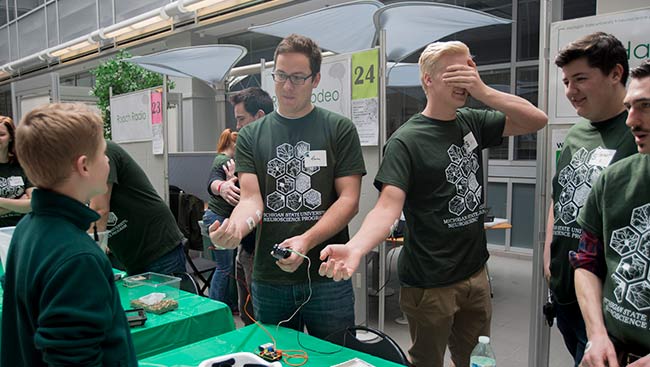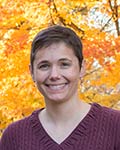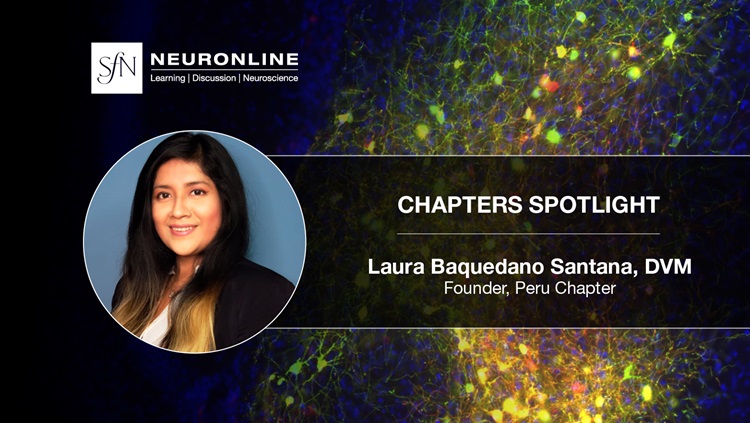
This resource was featured in the NeuroJobs Career Center. Visit today to search the world’s largest source of neuroscience opportunities.
In addition to teaching neuroscience courses at Michigan State University (MSU), Jennifer Taylor and Casey Henley serve as the neuroscience program’s outreach co-coordinators.
In this role, they spearhead events such as The Brain Bee, Neuroscience Fair, and Brain Awareness Week. They also find time to visit schools and senior homes, and participate in events organized by other MSU groups such as Math, Science, and Technology Summer Camp, Science Festival, and Take Your Child to Work Day.
Here, Taylor and Henley share separately how their individual careers have evolved to incorporate outreach in an official capacity alongside their teaching portfolio and then jointly delve into what they've learned about outreach and career development from this unique experience.
What training and/or career experiences led you to each serve as an outreach coordinator for MSU?
Jennifer Taylor: My first experiences with outreach were at Adrian College, where I helped with a Magic of Chemistry Show, assisted teaching microbiology to elementary school students, and judged a science fair. As a PhD student at Wayne State University, I organized Brain Awareness Day events at the local science center and Brain Awareness Week visits to local schools. During my postdoc at the University of Michigan, I developed and led a booth to teach deep brain stimulation to kids during their Brains Rule! event.
Casey Henley: Outreach started for me in high school, when I volunteered at events introducing elementary school students to chemistry at Girl’s Math and Science Day. Although I was involved in a few events in undergrad and grad school, it wasn’t until I became a postdoc at MSU that I became serious about outreach, first joining a committee to launch a Brain Bee competition and neuroscience fair.
Overall, my education and interest in teaching prepared and inspired me to share neuroscience with the public. Effectively communicating science to nonscientists is a skill we should all practice. It’s critical to public science literacy and can have effects that range from sparking interest in children to affecting public policy and research funding.
Why types of responsibilities do you have as outreach coordinators?
Our outreach responsibilities are only a portion of our academic positions. Though it depends on the event, we generally spend a few hours a week (but can be up to 20) recruiting volunteers, scheduling facilities, requesting financial support, communicating with campus and community organizations, ordering supplies, and creating and updating activities.
What approaches do you use to encourage students, faculty, and department heads to participate in activities you organize?
We are fortunate that our outreach events have become part of the program’s culture.
The majority of our events take place at the same time every year so that our program students and faculty know well in advance when we will need volunteer help. We also try to make volunteering as easy as possible by:
- Organizing all of the supplies and giving clear directions for the activities.
- Providing snacks and a neuroscience program outreach t-shirt.
- Promoting ways outreach teaches valuable communication skills and is beneficial to include on CVs, resumes, and applications.
Which MSU outreach event has the most community impact, and what contributes to its success?
The Neuroscience Fair is our largest event, attracting as many as 1,100 attendees.
It takes place the Saturday of Brain Awareness Week and is free and open to the public. We set up around thirty booths of activities that range from crafts for younger students to cow eye dissections for older visitors.
Advertising is important. We share our event on Facebook and on local calendars, and with our community of local teachers. Since we have been running the Fair for six years, we have families that return every year and promote it to their networks.
Getting the word out brings in visitors, but our program volunteers and financial support make our event a success. MSU graduate students and faculty volunteers are the backbone of most of our events. We also have many undergraduate students that love showing their excitement about neuroscience. The Neuroscience Fair could not function without the time and effort from our neuroscience program community.
Finally, at this point, we know which activities work best and have mastered our execution timelines. We’ve also been successful at working out any issues that arise.
For students or faculty wanting to get involved in outreach at their institution without an established program, where do you suggest they start, and what resources would be helpful for them?
Either start small, partner with an existing outreach program on campus, or take advantage of potential pools of student volunteers, such as premed or science clubs. It’s also important to make sure you have a group of reliable and enthusiastic students, faculty, and staff to help and that your chair or director supports the idea before committing to an event.
Try to connect with people who have experience running outreach programs. SfN chapters are great learning resources because many run successful outreach events. We have a community of faculty from SfN’s Michigan Chapter that regularly shares and brainstorms outreach ideas.
Also consider visiting other STEM outreach events in your community. See if other departments on campus, local museums, schools, or zoos run programs you can attend to network with the organizers and get ideas.
Once you start planning, there are great online resources for developing activities. We often use BrainFacts, The Dana Foundation, Neuroscience for Kids, Backyard Brains, Journal of Undergraduate Neuroscience Education, and NIH.
What advice do you have for someone interested in using their neuroscience background to pursue an outreach career?
- Make connections. Attend professional meetings and network with people who run successful events and programs.
- Practice communicating your science. Volunteer, but strategically. It would be difficult to participate in every event.
- Keep your mind open in different settings. You’d be surprised when the best ideas for an activity can pop up.
And, remember that outreach can be one part of a more diverse job, like the positions we have.
If you have other interests like teaching, research, or advising, you can make outreach a part of that. If you are applying to a new job that isn’t a full-time outreach position, ask in the interview if a portion of your job can include some outreach responsibilities.
Show examples of your past events and emphasize how outreach improves communication skills, brings recognition to the department and institution, and improves community relations and science literacy.
Outreach truly benefits everyone involved.
*Photo provided by Casey Henley.
Speakers









